The message arrives from an unknown number on WhatsApp at about 6:30 p.m. on a Thursday evening.
Hi, regarding the mangoes …
I text back quickly for clarification.
Are you the lady getting mangoes from Nauman?
Yep, she responds instantly.
My heart leaps with joy. Just a 20-minute drive away, my box of Pakistani mangoes is here.
Would my contact be a local auntie dressed in a salwar kameez (traditional Pakistani garb)? Or would she be a 20-something like me, eager to get a taste of the beloved Chaunsa mangoes that had flown across the Pacific Ocean from Multan, Pakistan? Whoever she is, I think, I’m grateful she kindly scooped up a box for me on her trip to the mango middleman — Nauman Chaudary — in West Chester, Pennsylvania.
Chaudary became the middleman for mangoes in the Atlantic region when his friends and neighbors heard he was making trips to airports to pick up boxes from a mango supplier.
The West Chester resident told me about his journey to becoming the mango middleman earlier that week when I reached out for a story on how these mangos have built a local cult following.
People in his neighborhood would say, “Hey, if I get 12 boxes, we can share two” and that’s how it all began.
“And then this year, we kind of ended up going a little bit further. I said, ‘OK, let’s just do a little bigger project and let’s see how it works out,'” Chaudary said.
When shipments arrive, Chaudary sends out Facebook posts or WhatsApp messages for those interested in a box or three. The posts offer the brass tacks of what’s in the box and when it’s ready for pick up for those familiar with the magic of the mangoes. His Facebook post on a local South Jersey group is how I ended up at a young doctor’s home near the Philadelphia Museum of Art.
“Our next shipment of Pakistani mangoes date is July 13th IA (Inshallah or God willing), we are getting Chaunsa from Multan,” he had posted. “If anyone (would) like to order, please send me message with number of boxes. Cost of mangoes are $40 per box. Box is 2 kg, 4.4lbs, Chaunsa 5-6 pieces.”
Hira Qureshi
Because I put my order in at the last minute, Chaudary asks the Fairmount doctor to take my box back to Philly so I won’t have to drive to West Chester. The doctor texts me soon after, and I make my way over to her apartment the next day.
Waiting outside her home, my anticipation builds. My parents grew up joyfully devouring these mangos, but I had never tried them until now. My heritage was waiting in the shape of a yellow-skinned fruit right behind the door.
After about 10 minutes, the door opens and a woman in light blue scrubs hands me a medium-sized box wrapped in green tape with a quick, “Here ya go! Hope you enjoy them.”
The exchange is brief, but my excitement is palpable. I smile down at the box in my hands.
I rip the box open immediately, and my friend along for the drive notes the honey-like smell that wafts from the oval-shaped mangoes tucked in little netted cozies.
The next day, we gorge on the luscious fruit while sitting on beach towels at Stone Harbor beach.
Incredibly sweet and bursting with juice, these mangoes are a revelation. They help me understand the devotion and reverence for the natural sugar bombs grown in the provinces of Punjab and Sindh inspire and the love expressed in everything from mango kulfi (traditional ice cream) to romantic verses by famous poets like Mirza Ghalib who had a special fondness for the fruit.
The cultural significance of this glorious fruit is even referenced in the Marvel Cinematic Universe. In an episode of “Ms. Marvel,” Kamala Khan chats with her Nani (maternal grandmother) in Pakistan over FaceTime, and Nani gets distracted by the mango man who’s brought his cart outside her home.
The poet Mirza Ghalib is reputed to have said: “Mangoes need to have two qualities: they need to be sweet, and there needs to be plenty.”
Locally purchased mangoes cut into cubes.
Locally purchased mangoes cut into cubes.
Kevin Wexler
As I savored these lush mangoes, I felt the tether to my birth country and its culture strengthen. Each bite and suck on the mango seed transported me to my grandparents’ houses in Karachi and Lahore — where the unconditional love of family and the hot, muggy humidity always envelops me in its comforting embrace.
But I wondered, what did this fruit mean to others with ties around the globe? My search for meaning would show me that from the Philippines to Mexico, the perfect mango is about taste, texture, culture, memory and devotion.
For Pakistani immigrants and the diaspora, this longing for home-grown mangoes has created a semi-illicit trade across the U.S., according to Ahmed Akbar, a James Beard Award-winning writer.
Chaudary is one of many who run a tight ship on distributing mangoes.
While the Pennsylvania middleman picks up boxes from the Philadelphia International and Newark Liberty International Airport, another middleman (who requested to remain anonymous, using his pseudonym) in New Jersey covers either the Newark or LaGuardia Airport’scargo bay.
The middleman in Teaneck, New Jersey, is a Wall Street attorney who moonlights as the Aams (Urdu for mango) Dealer. The attorney provides his local community with Pakistani mangoes, as the fruit has a minimal presence in the U.S. due to supply chain and logistical challenges.
LOVE MANGOES? 8 places to score mango dishes in South Jersey
Pakistani mangoes did not receive approval for import by the Department of Agriculture until 2010, when former Secretary of State Hillary Clinton looked to improve diplomacy and trade relations.
“I have personally vouched for Pakistani mangoes, which are delicious, and I’m looking forward to seeing Americans be able to enjoy those in the coming months,” Clinton said in 2010 during a visit to Islamabad, Pakistan.
Exported fruits arrived in the United States only after years of “discussion and development between the government of origin and the USDA,” and the fruit must be irradiated to be approved and imported, Akbar reported for Eater. Irradiation for Pakistani mangoes involves a fungicidal dip and ionizing radiation to ensure agricultural pests do not enter our country.
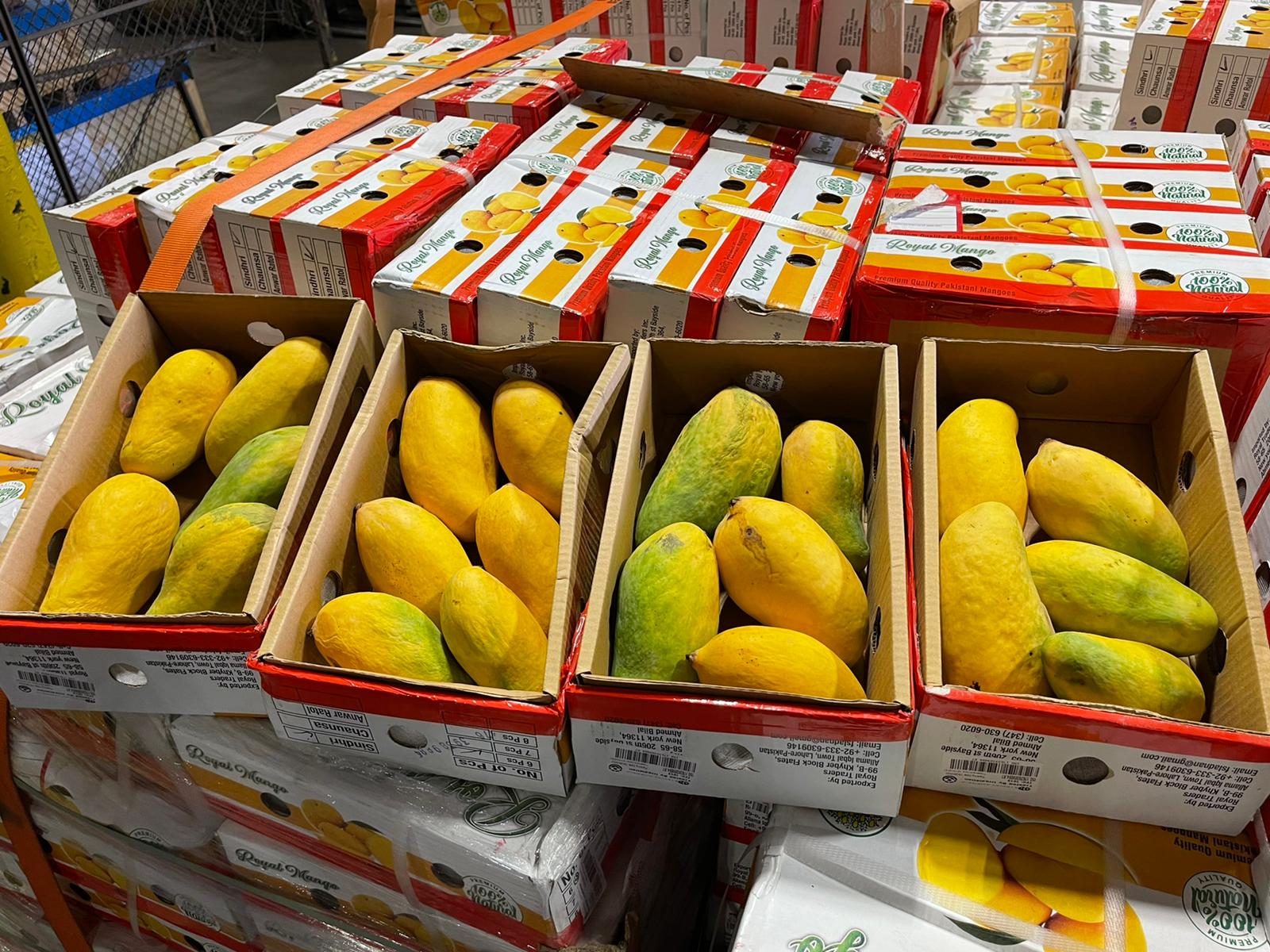
Provided by Nauman Chaudary
“But most mangoes from Asia, including those from India and Pakistan, have a strict irradiation requirement,” Akbar continued. “61% of Pakistani mangoes irradiated in the U.S. are treated with electron beam irradiation; the other 39% receive gamma irradiation.”
The Teaneck lawyer’s mango pick-ups began as a hobby to acquire the sweet fruit for his friends and family but soon grew into a massive undertaking when various Pakistani WhatsApp groups learned of the mangoes.
People will drive from Virginia to Teaneck for a box of Pakistani mangoes with pure sweetness and the longing for their heritage motivating them.
And although the Pakistani mango love is loud and proud, we aren’t the only people with an overwhelming adoration for the glorious fruit.
I spoke to various immigrants across the Atlantic region to learn just how deep the love for mangoes runs across cultures. Here’s what I found.
Phoneprasith “Phone” Dumas, who emigrated to the U.S. when she was 8 years old, associates mangoes with the trees she climbed as a child in her home country of Thailand.
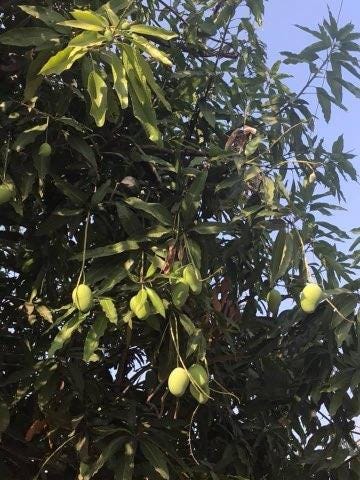
Provided by Phoneprasith “Phone” Dumas
“What I mean when I say it goes back as far as my memory is because I can’t even imagine a home or a neighbor back home, especially in the suburban, rural areas — it just seemed like everyone had their own little mango tree and their own variety, type of mango,” she recalled.
When she moved to Rochester, New York, Dumas was grateful for the abundance of mangoes imported from Latin America that she could readily find in local stores.
It satisfied the craving for mangoes, but she still missed the different types offered in Thailand.
“I remember one of the types of mangoes back home — what you do is you’re able to expel the seed and what’s remaining is the meat and the sweetness of it all; you could even stuff sticky rice in there,” Dumas explained. “You’ve got the whole skin of mangoes still intact … but that type of combination of sticking sticky rice into mango requires a certain type of mango.”
Much like Pakistani mangoes, Dumas said there are rules and regulations on importing Thai fruits. But with the expansion of commerce and trade over the years, she’s found alternatives that satisfy her cravings for produce from her home country.
“We can find them now in our local Asian grocery stores,” she said. “Certain fruits that you couldn’t even find 10, 15 years ago are now being grown in Florida … where the weather and soil are similar … You can’t find everything, but with respect to mangoes, I’ve been able to find two, three different varieties so far that’s available in the Rochester area.”
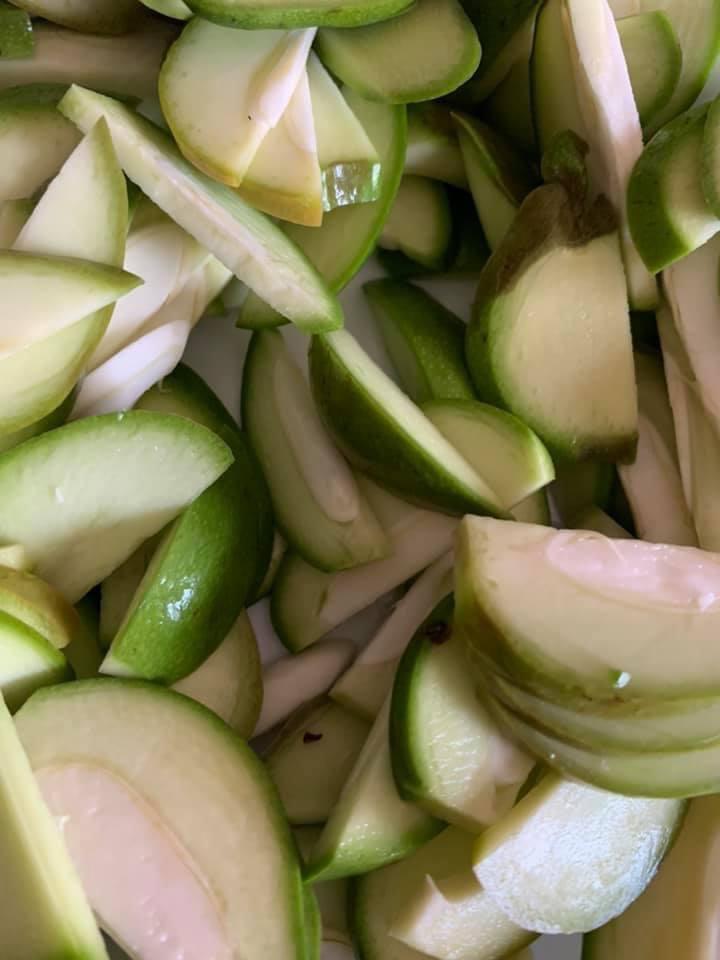
Provided by Phoneprasith “Phone” Dumas
What makes Thai mangoes so special? For Dumas, it’s the smell.
“When you cut into it, that’s when the essence of all the mango sweetness, the aroma — that’s when it’s at its heightened best,” Dumas said.
“Mango has that smell that’s unlike any other fruit,” she added. “You get that first sniff and you get that, ‘Ah, that’s a mango’ moment.”
Dumas, who operates a catering business in the Finger Lakes in upstate New York, has a process for ensuring the best-tasting experience. When she brings home mangoes, she lets them sit for five to seven days at room temperature to make sure they’re ripe.
The fruit is a versatile ingredient in Thai cuisine, enjoyed as a savory meal, dessert or snack.
Dumas makes mango sticky rice with coconut milk, palm sugar, cooked rice and mango on top for a classic Thai dessert. But when she’s in the mood for a tart treat, she will slice up a less ripe mango and turn it into a mango salad with spicy Thai chilies — a spicy, sweet meal.
Mangonadas and chamoyadas at La Mangonada Snack Bar in Pennsauken
Nuria Miranda, owner of La Mangonada Snack Bar in Pennsauken, speaks about mangonadas and chamoyadas.
Adam Monacelli/USA TODAY NETWORK NJ GROUP, Cherry Hill Courier-Post
Mangoes blended with sweetened condensed milk (or Dulce de Mango) is how Maria Karg enjoys the fruit. Or she cuts them into slices and tops them with Tajín (chile-lime salt) or Chamoy (a salty, sweet, sour, and spiced sauce).
The Erie, Pennsylvania, resident’s fondness for the fruit began when she was a child. She and her siblings would grab all the mangoes in her home in Mexico and devour them as they sat under the table.
“We would eat them, skin and all,” she joked. “We probably got rid of the skin somehow.”
Fruits were a staple in Karg’s home and at her grandmother’s house growing up, especially mangoes.
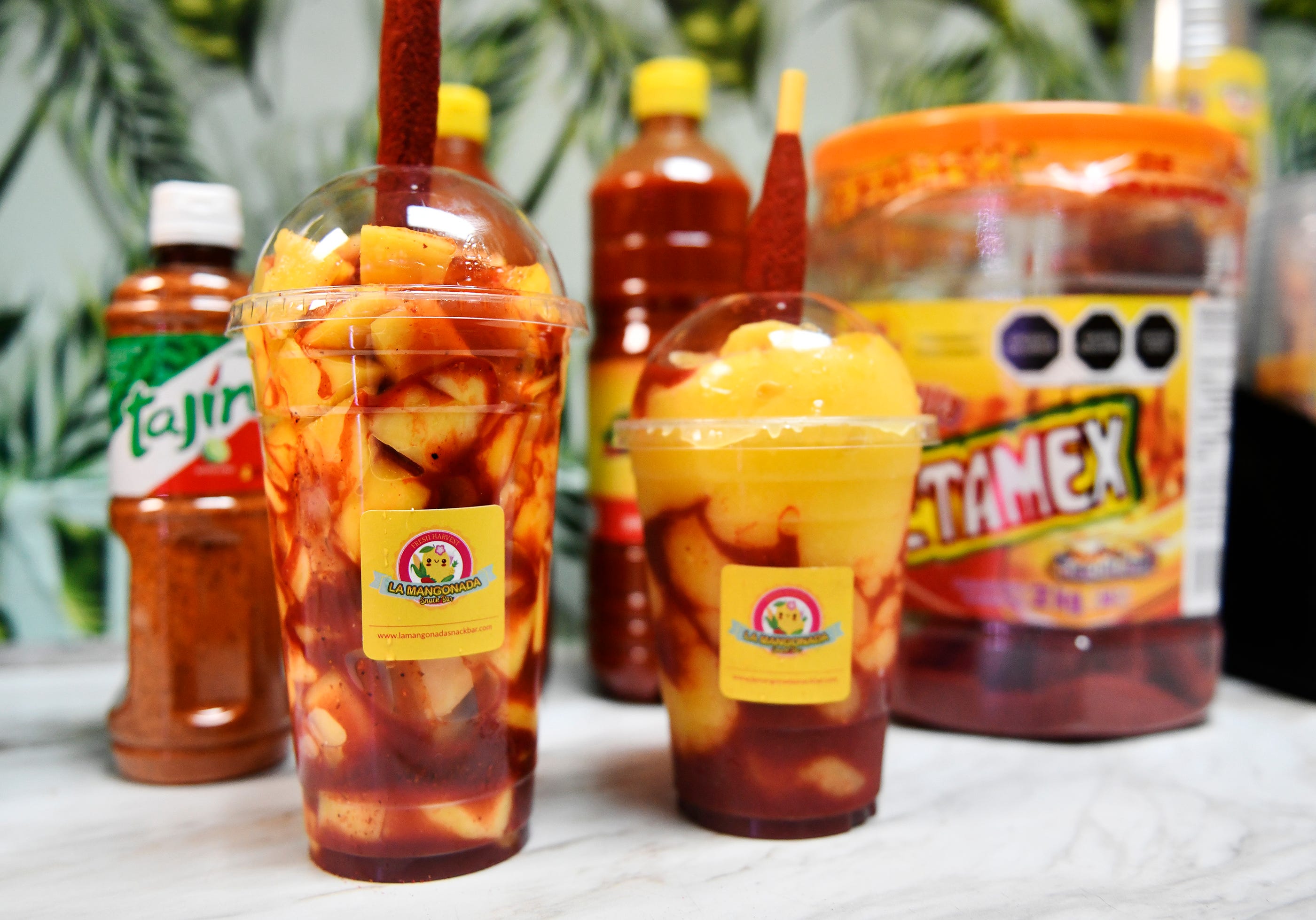
Adam Monacelli/Courier-Post
Karg also spent some of her childhood in Venezuela, where her family would pick mangoes from the neighborhood tree, an experience she misses since emigrating to the U.S.
“It’s fresher from the people selling them at the store.”
To pick the best mangoes, Karg advises feeling them for softness or hardness. If it’s not soft, it’s good and if it’s wrinkly, it’s no good, she said.
“When you’re like, ‘Oh I found a mango and it’s perfect,’ it makes me happy to eat them,” she said. “It’s soft and it’s nice. And even when it’s dripping juice all over you, it’s OK, because you’re eating a mango. It doesn’t matter.”
Karg mentioned the fruit is also found in the language.
“We say, ‘Esta como mango,’ when we are saying someone is attractive,” she explained. “He’s like a mango.”
Esta como un mangotote means “he’s like a big mango, to say they are very attractive,” she added.
Filipino mangoes are the best mangoes, argues Helen Castillo, a Jersey City resident, who works at the Philippine American Friendship Community, Inc.
“They’re round and sweet and big,” she described. “And they don’t have the fibers … it doesn’t go between your teeth.”
Since she emigrated to the states in 1994, Castillo’s go-to have been Mexican mangoes. For yellow mangoes, champagne (also known as Ataulfo) is what she gets. For green mangoes, she takes whatever she can find.
Kevin R. Wexler-NorthJersey.com
Growing up in the Philippines, Castillo would wait for mango season to come around to enjoy the fruit in all its forms from cakes and ice creams to shakes and juices.
“I’m very particular with a certain brand of yellow mangoes,” she said. “If it’s not available, I don’t buy it.”
The reason Filipino mangoes aren’t available in the U.S. is due to distance, as well as a lack of technology in the Philippines’ need to export the delicate fruit, Castillo guessed.
But there’s nothing like going home to the Philippines and gorging on the mangoes.
“When I go home to the Philippines, it’s like going back to your childhood,” she said. “Like being young again with those mangoes.”
Supsupin are small yellow mangoes only available in Tagaytay city that can be eaten without slicing, Castillo shared. Then there are the green mangoes that can be eaten before they’re fully ripe or green and enjoyed in a Filipino delicacy — sour, unripe green mangoes dipped in Bagoong, a salty fermented shrimp paste.
Castillo misses the variety of mangoes in her home country.
There isn’t a trade of suppliers and middlemen in the U.S. that Castillo is aware of to bring her the mangoes she craves. She said it would be very expensive to ship, and the mangoes would go bad after five or six days.
So, to bring her home Filipino mangoes to the states, Castillo has a little trick. She freezes the mango pieces like “mango balls” in Tupperware and wraps them in newspaper to put in her luggage.
“When people go to the Philippines and they taste the mangoes … then they say, ‘Yeah, it’s really different,” she said.
When cutting mangoes, ‘there’s no rules’
Helen Castillo explains why she has loved mangoes from an early age. Thursday, July 21, 2022.
Kevin R. Wexler, NorthJersey.com
Born and raised in the U.S., Anjan Patel had never experienced the juicy, sweet mangoes his parents grew up with in India.
For most of his life, the Mullica Hill, New Jersey resident would hear tales of how delicious the fruit was overseas. His parents, who have traveled back to India about four to five times, would come back with stories of the fruit.
“I never had the opportunity to taste the mangoes of India after 45 years (of my life),” Patel said.
So, he decided to take matters into his own hands and searched for Indian mangoes but couldn’t find any that shipped from abroad. There is a limited supply of Indian mangoes, Kesar and Alphonso, that come to their local grocery store but the boxes are gone within a day and charged double the price. (Alphonso mangoes are harder to find while Kesar is a bit easier, Patel said.)
“We might get our hands on the box or two of those a year,” he said.
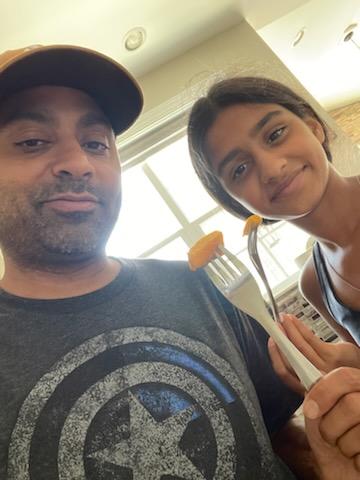
Provided by Anjan Patel
In his research, Patel stumbled on the Aams Dealer. He decided Pakistani mangoes were the next best option so he ordered a few boxes for his family and took the two-hour drive to Teaneck and picked up boxes of Anwar Ratol and Chaunsa mangoes.
When he got home, the Patels feasted.
“As soon as we cut it the entire house started smelling like fragrance — the fragrance was better than the taste,” he described. “It just smelled so delicious and aromatic. And the taste was like 100 times sweeter than the regular mango that we get in the grocery store.”
With mango season lasting about eight weeks, customers of the Aams Dealer have to wait a year for the season to come around and place their orders. So when Patel found the Aams Dealer last year, he penciled it into his calendar and kept in touch with the Teaneck middleman.
Patel made the trip up in late May for his first order. Then drove back up for the second and then later for the last order of the season.
“You’re taking the whole day off just to pick up mangoes that some would be like that’s crazy to do that,” he shared. “The first time I picked it up, I was like, ‘This is a one-time thing. I’m not gonna drive five hours round trip to get mangoes.’ But after tasting them I’m like, ‘Oh’ … For three times a year to travel five hours seems ridiculous but I think it’s worth it.”
For Patel’s parents, the Pakistani mangoes reminded them of home. The two said the mangoes had a similar sweetness to Indian mangoes, but the size and fragrance were a bit different.
His parents were excited to try them but more so for Patel to get a taste. The box came with six or so mangoes but his parents insisted he eat at least five, Patel laughed.
The Mullica Hill family usually cuts their mangoes into cubes and saves the seed for last.
“My mom always cuts mangoes for me so whenever she cuts them, she’ll like take the seed and she’ll enjoy that and she’ll just give us the cubed mangoes,” Patel said.
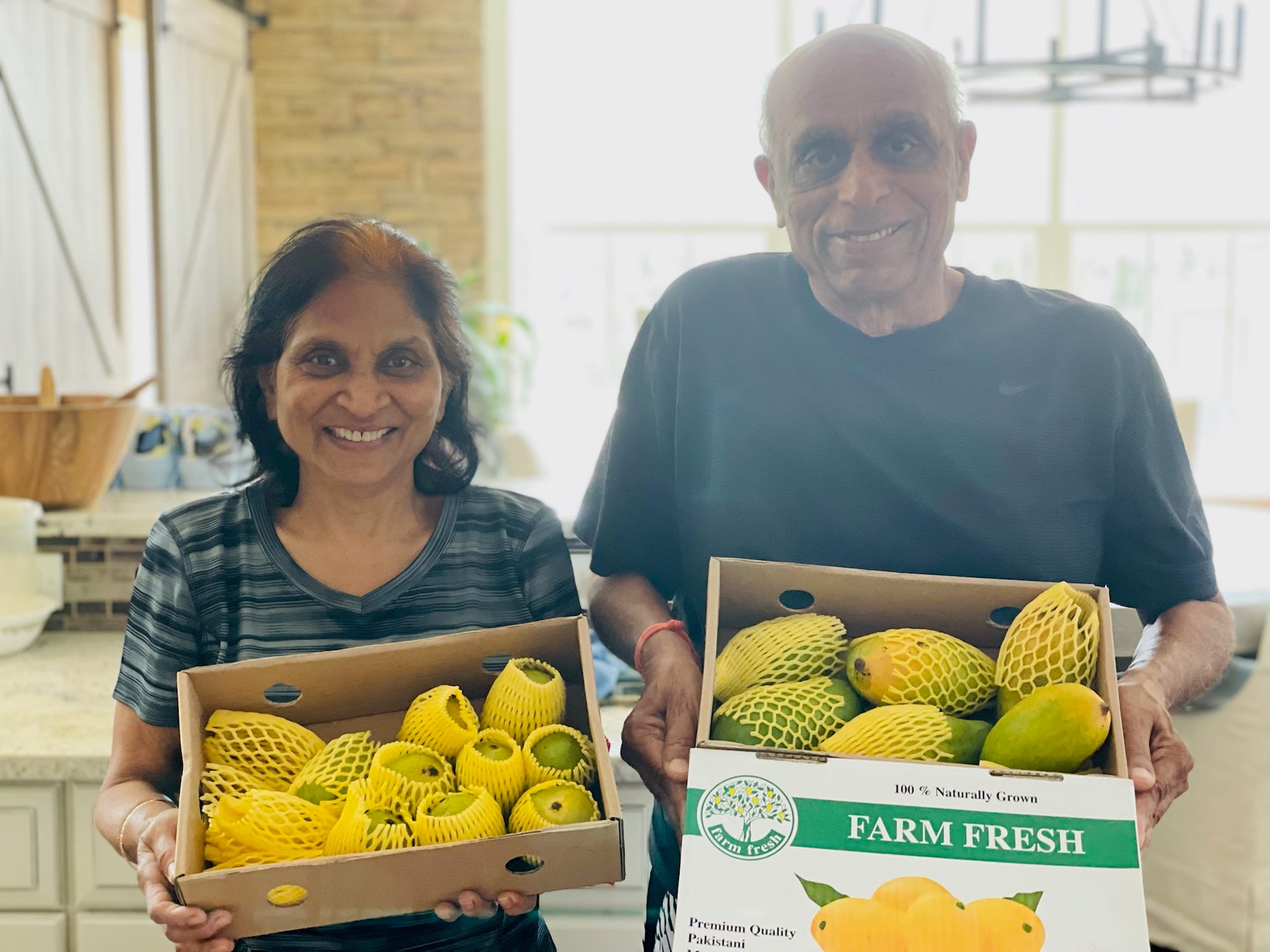
Provided by Anjan Patel
With the Pakistani mangoes being small and juicy, Patel suggests just biting into them like you would an apple after removing the skin.
“So much of the food is left on the seed itself, he explained. “You can’t really get cubes out of these Pakistani mangoes.”
Jet Lee knows all about cutting mangoes as the franchisee of Mango Mango Dessert in Atlanta, Georgia.
It’s the first thing Lee does when he gets to his store.
“I think I eat mango every single day except for Tuesday — day off,” he shared. “Every day when we get to the store, the first thing that we did is cut the mango. I would taste a small piece, little bit to make sure mango is sweet.”
Lee and his wife, Cindy Cheng, are former New York residents who followed their love for mangoes and decided to join the dessert chain dedicated to the fruit. Mango Mango Dessert has locations in Flushing, New York; Philadelphia, Pennsylvania; Cherry Hill, New Jersey and elsewhere.
Lee’s passion for mango comes from his Malaysian roots. Growing up there, he had a mango tree outside his house. Later, he moved to Singapore where mangoes also are adored.
Hira Qureshi
“In Southeast Asia, we love mangoes,” he said. “We use mango to (make) not just dessert, (but also for) cooking.”
When he emigrated to the U.S., Lee’s love for the fruit didn’t falter. He quickly fell for Mexican, Ecuadorian and Peruvian mangoes.
“Because I’m doing a mango dessert business. every single time either I cut it or eat it — it’s like my first love,” Lee said. “I have a communication with the mango, even though the mango cannot talk. I believe if you treat the mango well, (it) will treat you well as well. So when I cut it and serve the customers, everything will be perfect and sweet.”
Like Lee, Chaudary adopted Mexican mangoes after emigrating to the states.
But the mangoes available were “just to make me happy, just to eat mangoes.” There was still something missing.
Growing up in Pakistan, he would sit outside his home and wait for the mango carts to come. Then devour some and use the others for mango lassi, a chilled, yogurt milkshake.
Becoming the mango middleman was the way to relive his childhood.
“When you eat some of these mangoes, it feels even sweeter than honey,” he described.
“That’s the reason they call (them the) king of the fruits.”
Hira Qureshi covers food and drink for South Jersey at the Courier Post, Burlington County Times and Daily Journal. She can be reached at HQureshi@gannettnj.com or 856-287-8106. Help support local journalism with a digital subscription.